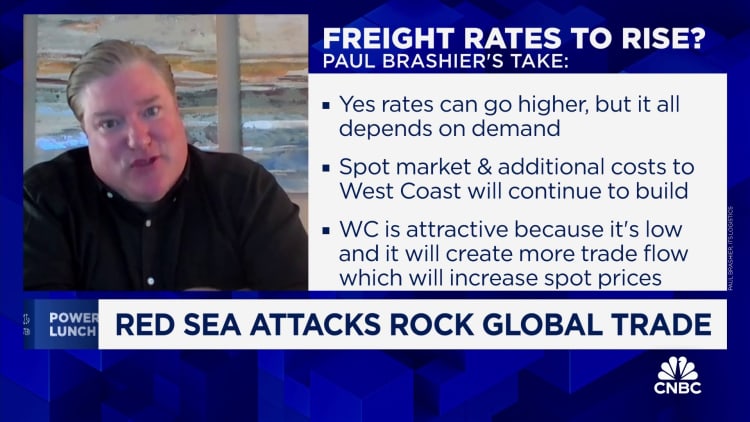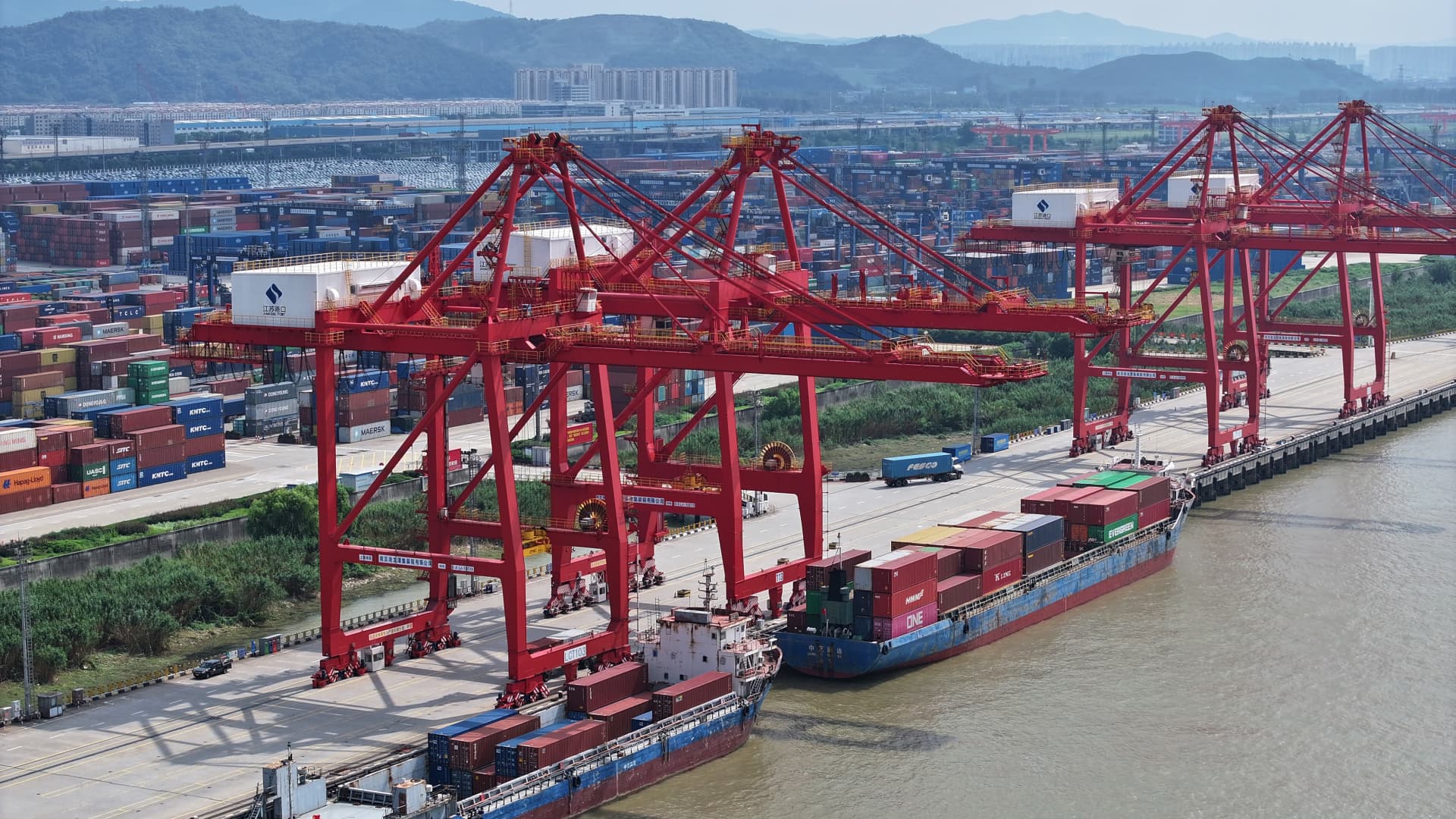Cargo ships dock at the Longtan Container Terminal of Nanjing Port to load and unload containers in Nanjing, Jiangsu province, China, Sept 6, 2023.
Nurphoto | Nurphoto | Getty Images
A slowdown in demand for products manufactured in Asia has ocean carriers reducing freight rates on shipping routes from China to the West Coast and canceling sailings, despite elevated fears about a new round of supply chain inflation caused by the Middle East conflict.
The cargo price cuts come despite the Houthi rebel attacks in the Red Sea which les some shippers to recently raise container fees as high as $10,000. Shipping giants including Maersk, which have had to halt shipments through the Red Sea in recent weeks, continue to warn of the ongoing threats to the global economy. As the U.S. and its allies launch attacks against the Houthis, fears are running high about an inflation spike for the global supply chain, but the latest shipping contract data shows that on some key routes that is not yet happening.
Rates for new ocean freight contracts scheduled to go into effect Monday, January 15 for many carriers were expected to rise above $5,000, but a new advisory to clients from Honour Lane Shipping shows Asia to U.S. West Coast container prices coming in below that level — U.S. East Coast routes remain higher, at $6,500 to $7,000.
Alan Baer, CEO of logistics company OL USA, said there appears to be a growing divergence between the shipping rates to the U.S. coasts. “U.S. West Coast rates have rolled over and are decreasing,” Baer said.
More shippers were expected to start avoiding the East Coast and favor the West Coast ports as a result of the Middle East issues. Diversions from Egypt’s Suez Canal, which feeds into the Red Sea, and the rerouting of vessels around the Cape of Good Hope adds two to four weeks to a round-trip voyage, according to Honour Lane Shipping, and ocean carriers need more ships on each Asia-East Coast route to maintain an efficient network schedule.
But Baer says the data does not support the view that the situation has shifted more trade to West Coast routes. “Perhaps the diversion away from the U.S. East Coast has not prompted as significant an increase to U.S. West Coast volume as first anticipated,” he said.
Baer says there could potentially be more cancelled sailings to come in February to help balance actual supply and demand.
Still, rates are in flux, reacting to a very sensitive market, and pricing pressures will remain, according to Goetz Alebrand, head of ocean freight for the Americas at DHL Global Forwarding.
“Ocean freight rate adjustments are made in the same each week nowadays,” said Alebrand. “It could be seen as an adjustment to supply and demand. We expect this situation to remain fluid but generally see more chances for rates to remain elevated.”
The ongoing drought issues at the Panama Canal, which this week led Maersk to re-route some cargo by a “land bridge,” are adding to the global freight complexities.
C.H. Robinson describes the current global ocean shipping situation as one in which clients should move quickly to secure space in “a competitive capacity market,” according to a recent commentary from Matthew Burgess, vice president of global ocean services, and it recommends booking at least three to four weeks in advance for ocean freight on all routes.

Under the U.S. Shipping Act, all ocean carriers have to give 30-day notice before they can impose surcharges or GRIs, but the Federal Maritime Commission has waived this for shipments from Asia to the U.S. being rerouted around South Africa’s Cape of Good Hope.
Maersk declined to comment on new contract rates, citing a quiet period. CNBC reached out to other major ocean carriers for a comment, but did not receive immediate responses.
A decrease in Asia manufacturing demand is the reason behind a decision from MSC, the world’s largest carrier, to cancel sailings. “MSC plans to adjust its capacity in line with the slowdown in demand on Asia – USA and Canada routes due to the Chinese New Year period,” it said in a recent advisory to clients.
The reduction in China freight demand is in line with a CNBC Supply Chain Survey forecast for 2024 in which logistics executives who manage freight manufacturing orders and transportation — including those at C.H. Robinson, SEKO Logistics, DHL Global Forwarding Americas, Kuehne + Nagel, OL USA and ITS Logistics — warned of a decrease in demand ahead of Lunar New Year.


